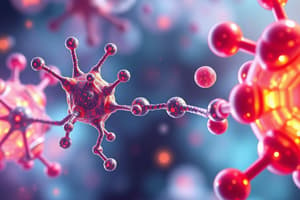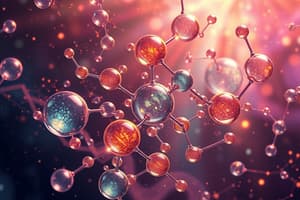Podcast
Questions and Answers
Which element can form the greatest number of bonds?
Which element can form the greatest number of bonds?
- Phosphorus
- Nitrogen
- Carbon (correct)
- Sulfur
What is the bond number of hydrogen?
What is the bond number of hydrogen?
- 1 (correct)
- 3
- 2
- 4
Which of the following is a primary alcohol?
Which of the following is a primary alcohol?
- 2-propanol
- 2-butanol
- 2-methyl-2-propanol
- Ethanol (correct)
Which of these functional groups contains a carbonyl?
Which of these functional groups contains a carbonyl?
What type of functional group is ethanoyl chloride?
What type of functional group is ethanoyl chloride?
Which of the following elements can form up to six bonds in some cases?
Which of the following elements can form up to six bonds in some cases?
What type of functional group is ethanoic anhydride?
What type of functional group is ethanoic anhydride?
Based on the information, how many bonds can phosphorus typically form?
Based on the information, how many bonds can phosphorus typically form?
What is the normal valency of a neutral carbon atom?
What is the normal valency of a neutral carbon atom?
What geometric shape describes the arrangement of bonds around a carbon atom in methane?
What geometric shape describes the arrangement of bonds around a carbon atom in methane?
Which of the following accurately describes the mirror image of methane?
Which of the following accurately describes the mirror image of methane?
What is the necessary feature to represent a carbon atom bonded to four different groups?
What is the necessary feature to represent a carbon atom bonded to four different groups?
How are optical isomers of lactic acid differentiated?
How are optical isomers of lactic acid differentiated?
What is the bond angle in a tetrahedral arrangement around a carbon atom?
What is the bond angle in a tetrahedral arrangement around a carbon atom?
Which condition causes mirror images to be non-identical in carbon compounds?
Which condition causes mirror images to be non-identical in carbon compounds?
What term describes the type of bond shown by the wedge in the 3D representation of a carbon compound?
What term describes the type of bond shown by the wedge in the 3D representation of a carbon compound?
Which group surrounding the central carbon atom is assigned the highest priority according to the Cahn-Ingold-Prelog rules?
Which group surrounding the central carbon atom is assigned the highest priority according to the Cahn-Ingold-Prelog rules?
When assigning priority to groups around a central carbon atom, what is the lowest priority group typically designated?
When assigning priority to groups around a central carbon atom, what is the lowest priority group typically designated?
How do you determine the order of priority for two carbon atoms surrounding a central carbon?
How do you determine the order of priority for two carbon atoms surrounding a central carbon?
In the context of assigning (R) or (S) configurations, which direction indicates an (R) configuration?
In the context of assigning (R) or (S) configurations, which direction indicates an (R) configuration?
Which of the following describes the configuration of the optical isomer of lactic acid that is characterized by an (S) configuration?
Which of the following describes the configuration of the optical isomer of lactic acid that is characterized by an (S) configuration?
What is the key characteristic when visualizing the lowest priority group during the configuration assignment?
What is the key characteristic when visualizing the lowest priority group during the configuration assignment?
Based on the Cahn-Ingold-Prelog rules, how is priority assigned to a carboxylic acid group compared to other groups?
Based on the Cahn-Ingold-Prelog rules, how is priority assigned to a carboxylic acid group compared to other groups?
Which of the following statements about assigning (R) and (S) configurations is false?
Which of the following statements about assigning (R) and (S) configurations is false?
What is the configuration of the optical isomer that is referenced as having an (S) configuration?
What is the configuration of the optical isomer that is referenced as having an (S) configuration?
Which of the following correctly identifies the type of carbon chain represented by the formula CH3-CH2-CH2-CH2-CH2-CH2-CH3?
Which of the following correctly identifies the type of carbon chain represented by the formula CH3-CH2-CH2-CH2-CH2-CH2-CH3?
What is the most stable molecular conformation for alkanes?
What is the most stable molecular conformation for alkanes?
What type of bond is present in oleic acid that makes it a monounsaturated fatty acid?
What type of bond is present in oleic acid that makes it a monounsaturated fatty acid?
When drawing a skeletal structure of a carbon chain, which of the following is true?
When drawing a skeletal structure of a carbon chain, which of the following is true?
Which term describes alkanes due to their maximum hydrogen content?
Which term describes alkanes due to their maximum hydrogen content?
In the context of fatty acids, what does the term 'omega-9' refer to?
In the context of fatty acids, what does the term 'omega-9' refer to?
Which of the following correctly describes the term 'conformations' in alkanes?
Which of the following correctly describes the term 'conformations' in alkanes?
Study Notes
Important elements in Biology
- Six important elements in biology are Carbon (C), Hydrogen (H), Nitrogen (N), Phosphorus (P), Oxygen (O) and Sulfur (S).
Valency of elements found in biomolecules
- Carbon (C) can form 4 bonds.
- Hydrogen (H) can form 1 bond.
- Nitrogen (N) can form 3 bonds.
- Phosphorus (P) can form 5 bonds (sometimes 3).
- Oxygen (O) can form 2 bonds.
- Sulfur (S) can form 2 bonds (sometimes 6 or 4).
Functional groups in biomolecules (1)
- Carboxylic acids contain a -COOH functional group.
- Aldehydes contain a -CHO functional group.
- Ketones contain a -CO- functional group.
- Esters contain a -COOR functional group.
- Biomolecules with a (C=O) group are called carbonyls.
Functional groups in biomolecules (2)
- Acid anhydrides contain a -COOCO- functional group.
- Amides contain a -CONH2 functional group.
- Thioesters contain a -COSR functional group.
Functional groups in biomolecules (3)
- Acid chlorides contain a -COCl functional group.
- Haloalkanes contain a C-X functional group (where X is a halogen, such as F, Cl, Br, or I).
- Haloarenes contain a C-X bond attached to an aromatic ring (where X is a halogen, such as F, Cl, Br, or I).
Functional groups in biomolecules (4)
- Primary alcohols.
- Secondary alcohols.
- Tertiary alcohols.
Functional groups in biomolecules (5)
- Primary amines contain an -NH2 functional group.
- Secondary amines contain an -NHR functional group.
- Tertiary amines contain an -NRR' functional group.
Functional groups in biomolecules (6)
- Phenol contains a -OH group directly bonded to a benzene ring.
- Thiols contain an -SH functional group.
- Phosphodiester linkages are found in DNA and RNA.
Tetrahedral geometry
- When neutral carbon has only single bonds (sp³ C) the arrangement is tetrahedral.
- The bond angle in a tetrahedral arrangement is 109.5°.
- A diagram of a tetrahedron shape. The bond angles between the bonds should be specified as 109.5°.
- The arrangement of bonds at saturated C (only single bonds) is tetrahedral.
Optical Isomers
- If 4 atoms or groups around carbon are the same, the mirror image is the same.
- If 3 atoms or groups around carbon are the same, the mirror image is the same.
- If 2 atoms or groups around carbon are the same, the mirror image is the same.
- If all 4 atoms or groups around carbon are different, the mirror image is not the same.
- When there are 4 different atoms or groups around C, it is necessary to use 1 dash and 1 wedge bond.
- The wedge bond is a bond in front of the plane and the dash bond is behind the plane.
- One mirror image is called the (R) form, the other is called (S) form.
Cahn-Ingold-Prelog Rules
- Assign a priority to each of the 4 groups surrounding carbon.
- First look at each atom around the central C. The atom with the highest atomic number is '1'.
- Hydrogen has the lowest atomic number.
- If the two remaining atoms are the same element, look at the next atom out from C.
- Join the numbers 1 & 2 with an arrow. If the arrow goes clockwise, then the configuration is (R). If the arrow goes anticlockwise, then the configuration is (S).
Alkanes
- A chain of single carbon–carbon bonds and C–H bonds is called an alkane.
- In the skeletal structure of an alkane, hydrogens are not drawn but are assumed to be present (only the carbon chain is drawn).
Alkenes
- If a carbon–carbon double bond is present, the molecule is called an alkene.
- Alkanes have the maximum number of hydrogens and are therefore said to be ‘saturated’. Alkenes have fewer H atoms and are therefore ‘unsaturated’.
- Oleic acid is a monounsaturated fatty acid because it has 1 C=C double bond.
- To identify omega-3 fatty acids, count the positions from the last carbon atom in the carboxyl group (CO2H) to the first double bond.
- Oleic acid is an omega-9 monounsaturated (healthy) fatty acid.
- Note:* The text provided describes the structure and properties of fatty acids which are covered in greater detail in organic chemistry courses. This note contains only a brief introduction to this complex topic.
Studying That Suits You
Use AI to generate personalized quizzes and flashcards to suit your learning preferences.
Related Documents
Description
Test your knowledge on the six important elements in biology and their valencies. Explore the different functional groups present in biomolecules, including carboxylic acids, aldehydes, and amides. This quiz will help deepen your understanding of the building blocks of life.




